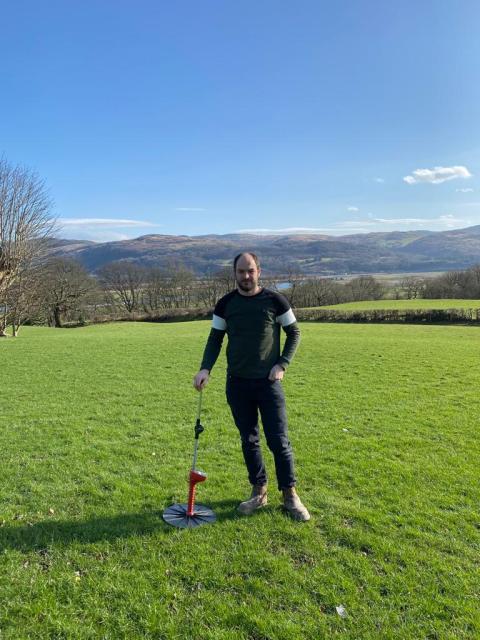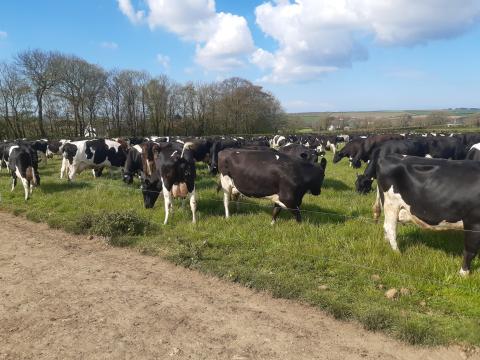Richard Rees
Farm name and location: Penmaen Bach, Pennal, Machynlleth
Sector: Red Meat (Sheep)
Being lightly stocked, we have been lucky over the last couple of months; we have managed to keep average farm cover fairly consistent around 2200kgDM/ha, with an average grass growth rate of around 20kgDM/ha, which matched our demand.
Maintaining quality has been the main challenge for us, especially with plants quickly running to seed due to heat stress. To manage the feed we have on farm, we have prioritised better-quality pasture for low Body Condition Score (BCS) dry ewes, and sent high BCS ewes up the mountain to reduce demand on the grazing platform.
We have managed to send three-quarters of our lambs finished off grass so far, averaging 37kgLW; the herbal leys have allowed us to keep these lambs growing, with the chicory and plantain performing very well. We will aim to get all the lambs off the grazing platform by 1 October to free up pasture for tupping the ewes.
Before and during the dry period, we aimed to graze higher covers and leave higher residuals, not grazing below 1800 kgDM/ha. This helped by protecting the soil from the high temperatures, thus conserving moisture, but also leaving low-quality pasture that we could then graze with dry ewes. This helped us carry enough feed into the drought to not need to feed out any supplement.
For winter forage, we planted a crop of swedes at the start of June, and we plan to graze with ewes from early December until ewes are housed for lambing in March. This will provide at least 90 days’ rest to all the fields on the farm over winter. Prior to grazing, we will use the cut-and-weigh method to estimate how much feed we have on hand (tDM/ha), and then calculate how much silage we need to feed alongside the crop to achieve the desired 90 days.
To manage the grazing and tupping and encourage a high conception rate this autumn, we plan to move to a quicker rotation (20-25 days), aiming to just take tops off the grass to provide the ewes with as much high-quality feed as possible, starting 10 days before the rams are introduced. For convenience, all 300 ewes will be in one tupping group.
We have now got to a point on the farm that all fields are split into roughly 1.5ha paddocks. This allows ewes to be on two-day moves, making management easier and allowing us to utilise and grow a lot more grass.
Then post-tupping, we will graze it down tight to 1500kgDM/ha residuals, to ensure we are leaving a clean base to grow high-quality grass in late autumn to carry over to the spring. We will aim to close the farm with a cover of 2000kgDM/ha. We know we will be able to grow some pasture over winter, so this cover target will ensure our pre-grazing covers are not too high when we arrive in spring.
Next season, our main priority is to increase stock numbers and the area of herbal leys on the farm. We currently have 7ha of herbal leys; they have proven critical for keeping lambs growing through the season and achieving a lower days-to-slaughter average off pasture alone.
Peter and Jackie Storrow
Farm name and Location: Rogeston Farm, Portfield Gate, Haverfordwest
Sector: Red Meat (Beef)
Based in Pembrokeshire, we have had a tough grazing season this year, averaging around 10kgDM/ha growth over the last couple of months, with average cover dropping down to 1850kgDM/ha on the grazing platform.
One thing that saved us through the dry period was having a very diverse cover crop, which we planted in May originally, to graze over winter with the dry cows. However, with a large feed deficit on farm, we made the decision to start grazing that in August, with 49 cows and 35 calves. This allowed us to reduce demand on the grazing platform. We have still got 39 heifers grazing the cover crop today.
Our next action to deal with the drought was to wean 22 cows and sell early as culls. This has reduced feed demand, and allowed us to take the opportunity to develop herd genetics by mating more heifers. One thing that we are really pleased about is that we have managed to maintain good cow condition, and the calves have grown very well – so, despite having a tough grazing season, we are hopefully still set up for a good one next year.
We have been feeding out silage for six weeks; for two to three weeks, we were on full winter ration, with cattle grazing the intended winter cover crop and buffered with silage. This has left a hole in forage supply for this winter, and meant we had to try a few new things to try and build our forage stocks back up.
This year, we have 160 tonnes of silage, which is not enough to get us through the winter. We managed to secure 100 bales of low-quality silage, and have just planted 30 acres of a multi-species cover crop with 3m intervals of forage rape for winter grazing. We also planted 65 acres of Westerwolds Italian ryegrass after potatoes; we placed a starter fertiliser down the spout alongside the seeds, which has made a big difference, encouraging rapid plant establishment. For us, it is critical that we have enough forage crops to be able to out-winter cows, as this can make huge cost savings to our business. We saved a significant amount last year through reducing the need for straw by keeping cows outside – and that’s before we looked at the added labour and machinery cost of housing cows.
This year, we have used very little fertiliser, with some foliar nitrogen used early on in the grazing season. We stopped applying fertiliser during the dry period, and most of the grazing platform had 27-30 (kgN/ha) a couple of weeks ago, as there was not enough cover for foliar nitrogen.
Currently, we are still lower on pasture cover than we would like for this time of year. The plan now is to wean all of the cows and keep them indoors for a brief period to dry off and allow pasture covers to build. We will keep all cattle on daily moves to reduce ‘on time’ and maximise potential regrowth of pasture, before the day length and temperatures drop too much. In November, we aim to stop grazing and provide each field with 120 days’ rest, before grazing again in spring.
Andrew Rees
Farm name and location: Moor Farm, Walwyn’s Castle, Haverfordwest
Sector: Dairy
Things took off well in the spring and went down from there. We have seen poor pasture growth from mid-June, with only one week over 30kgDM/ha growth and dropping down to 0kgDM/ha growth for a week. Our demand is usually at 50kgDM/ha, so we have been in a deficit for the last couple of months.
Our first decision was to extend the rotation length to 40-50 days, allocating a set area per day and filling the feed gap with forage. For example, if we had 100ha grazing platform on a 50-day round, we would allocate 2ha per day.
Initially, we didn't want to increase concentrate use, due to the cost. We completed a winter feed budget, so we knew how much silage we needed over winter, and set ourselves a limit as to how much we could use during the dry period. Once we ran out of this, we purchased silage in for five weeks, and have also bought in wholecrop and hay.
The next decision we made was to reduce the frequency of milkings to 11 milkings, instead of 14, in seven days. This helped us reduce cow demand and made it easier to maintain body condition. I am considering moving to once-a-day milking when we approach late lactation; the main reason for this is to help increase cow condition after the dry period to ensure we have a good season next year.
The farm is now improving, and we are now holding a 40-day round. We currently have a cover of 2130kgDM/ha, whilst still feeding 10kgDM/ha of silage, 5.5 kgDM/ha of meal and only 2.5kgDM/ha pasture to help the farm cover recover as we go into autumn, and take advantage of hopefully good growth the next couple weeks, before day length shortens.
We stopped applying fertiliser during the dry period, as fertiliser is used to accelerate growth – with no growth present, there was no point applying it. We also didn't want to build up nitrates in the soil for when the rain arrived and they were taken up by the plants, as it can cause problems with cow health.
Total fertiliser use for the year is likely to be around 50-60kgN/ha on the grazing platform, dropped from around 85kgN/ha last year.
The amount of pasture we grow on farm varies significantly year, from May to August this year, we have grown 5tDM/ha; in 2021, we grew 6.6tDM/ha, and in 2020, we grew 8tDM/ha.
Throughout the drought, the plants that have kept greener for longer include chicory, red clover and cocksfoot. Everything else seemed to vanish. We are using a tow and fert machine on the farm which has allowed us to reseed clover, chicory and plantain onto recently grazed paddocks.
Performance-wise, the cows are back on performance this year; in August, we were 10% back production wise, with milk solids down, due to the poorer quality feed available.
Our focus now is on protecting and building cow condition. We have enough quality silage to milk through the back end of the year, but want cows in good enough condition to hold dry cows on hay and good pasture covers in spring. This year has been hard, but if we try and squeeze too much out of it, we will pay for it next year.
We usually aim to have 2600-2700kgDM/ha cover in September, to allow us to extend our grazing season and close on 2200-2100kgDM/ha at the end of grazing. At the moment, we are trying to build as much cover as we can get, and will be happy if we get over 2400kgDM/ha.
R1s will be outwintered on a 7ha youngstock block, which we closed off on 7 July to allow pasture covers to grow for deferred winter grazing. We have placed out around 200 bales of silage, which should last them for two-and-a-half to three months’ grazing, depending on the growth we get over the next few months. This will provide a rest for the remaining grazing block.


